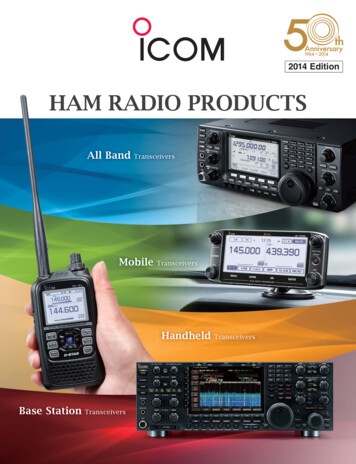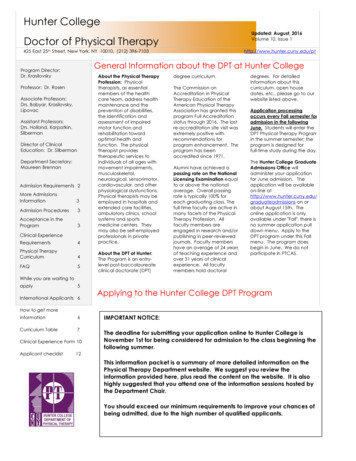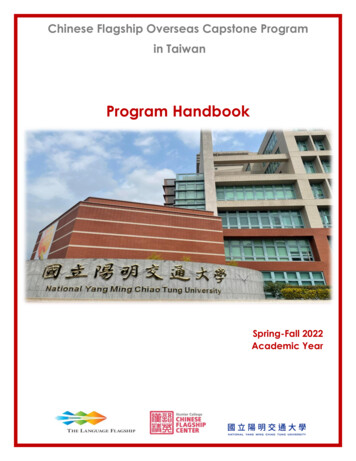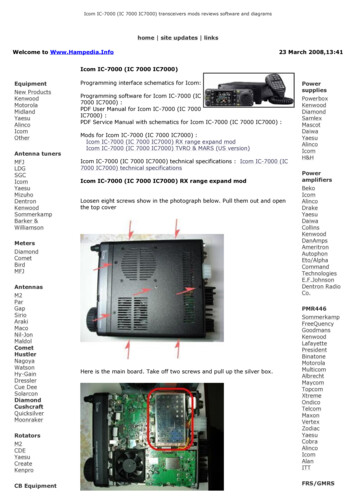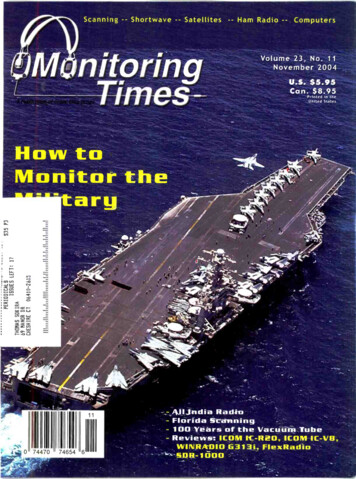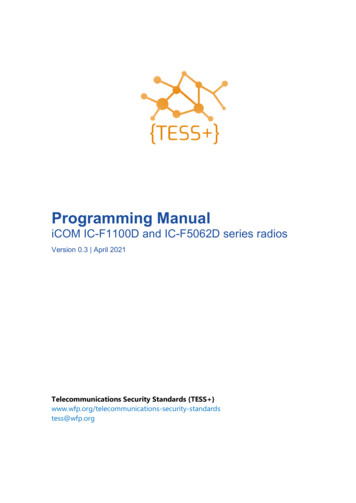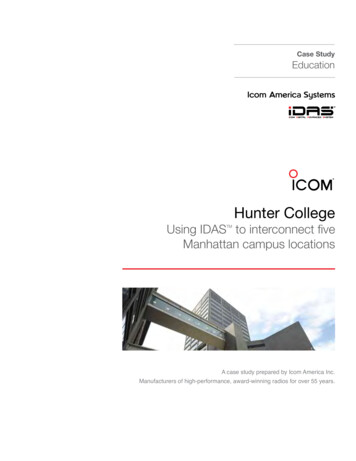
Transcription
Case StudyEducationHunter CollegeUsing IDAS to interconnect fiveManhattan campus locationsTMA case study prepared by Icom America Inc.Manufacturers of high-performance, award-winning radios for over 55 years.
Hunter CollegeUsing IDAS to interconnect fiveManhattan campus locationsTMMaintaining Safety in a Crowded Urban SettingESS, Inc. integrates wireless two-wayradio communications and IP, computernetworks, & access control specializingin radio interoperability, wireless broadband, and surveillance for governmentagencies, universities, hospitals, utilities.ESS covers NJ, NYC, Long Island,NY Metro area.Founded in 1870, Hunter College is the largest college in the City University of NewYork (CUNY) system. Comprised of five distinct campus locations geographicallydispersed across Manhattan, the college serves 23,000 students pursuingundergraduate and graduate degrees in more than 170 different programs of study.While maintaining a safe and secure campus is imperative for any college oruniversity, Hunter College’s highly urban environment and multiple campus locationsadd an additional layer of complexity to the task. Essential to protecting HunterCollege’s the students and staff is the ability to contact personnel located throughoutManhattan at the press of a button. Instant, direct communications can help preventincidents, and in the case of an emergency, college officials can respond quicklyand efficiently.“One block in either direction from our campus, we would loseour signal or be trampled by another user. We wanted a privatelycontrolled system so we wouldn’t have to share bandwidth withother users.”— Louis Mader, Hunter College Director of Public SafetyFeatured Products: IDAS F4161D Portables IDAS FR6000 Repeaters“Instant communication is vital to our role on each of the campuses,” says LouisMader, Director of Public Safety for Hunter College. “We oversee the safety of fivecampuses and 23,000 students in Manhattan’s crowded, urban setting. Two-wayradio provides instantaneous communication with our personnel, which allows us torespond quickly.” Hunter College’s Public Safety Department, comprised of 135employees, oversees law enforcement, EMT and fire response across all fivecampuses.Coordinating operations across multiple campus locations also poses a uniquechallenge for Hunter College’s Administration, Facilities Management andInformation Technology Departments, who oversee personnel and activities atmultiple campus locations. In addition, college administration must stay up-to-2Hunter College: Case Study
date on localized traffic conditions, special events and emergency situations thatcould affect the college’s regular operation. For example, President Obama’s 2010surprise visit to Manhattan gnarled traffic and caused severe delays and detours tosubway and bus routes, requiring increased security and class cancellations at amoment’s notice.Traditional Solutions Prove Cost-ProhibitiveRecognizing the critical role of reliable communications in ensuring student safety,Hunter College began investigating different solutions capable of connecting all fivecampuses in a single system. The solution had to provide reliable coverage acrossManhattan’s urban landscape as well as exceptional in-building coverage, even indifficult-to-reach underground areas.The solution also needed to support highly secure communications. With itsprevious UHF analog conventional system, the college shared bandwidth with otherusers, which compromised the security of the Public Safety Department’scommunications, Mader says. “One block in either direction from ourcampus, we would lose our signal or be trampled by another user,” heexplains. “We wanted a privately controlled system so we wouldn’t have toshare bandwidth with other users.”The final impetus for upgrading to a new communications system camefrom the FCC’s looming narrowbanding deadline, which requires all VHFand UHF land mobile radio users to migrate to at least 12.5 kHz channelsby Jan. 1, 2013. “The [FCC narrowband mandate] wasn’t our primarymotivation for looking for a new system, but it provided the push the collegeneeded to approve funding for the project,” Mader says.While a conventional radio system could easily provide reliable two-waycommunication across Manhattan, a traditional system would be cost-prohibitive.An IP-based system, on the other hand, would be affordable, but a previouseffort at implementing a pure IP system failed to provide the reliable, high-qualitycommunications required by the school.A Single Solution for Multiple LocationsHunter College contacted Joanna Harrington, Senior Account Manager at ESS Inc.,to look at other alternatives. She recommended a hybrid system consisting of anIcom IDAS conventional voting system on the main campus, connected via IP toremote campus sites. Cost-effective and cutting-edge, the solution would satisfythe college’s need to link its multiple campus sites with a reliable, high-qualitycommunications solution.3Hunter College: Case Study
Initially conceived as a solution exclusively for the Public Safety Department,Hunter College administrators quickly saw its potential for boosting organizationalefficiency across the college’s various departments. An IDAS conventional votingsystem would provide full coverage across Manhattan while solving the dilemmaof extending coverage indoors, especially in the underground areas near subwaytunnels.Different departments could share the system, and public safety would still havethe dedicated, secure channels it required. Finally, an Icom digital 6.25 kHzIDAS system, would provide a future-proof solution exceeding FCC narrowbandstandards that easily could be expanded or upgraded to meet the school’s futurecommunications needs.After a demonstration of the IDAS system in the ESS Field Staging Facility and anon-site demo of Icom’s F4161D digital portable radios, Hunter College decided toimplement a new hybrid IDAS 6.25 kHz digital two-way radio system. What sealedthe deal for Hunter College, however, was the simplicity of the purchase process,Mader says. “The ease of procurement by using the state contract sold me. Wedidn’t have to go through a formal bid process. It was simple.”Unique Hybrid System Combines Voting and IPHunter College’s new system is comprised of a conventional voting systemon the main campus, with IP connections linking the four remote campus sites.Four repeaters provide full coverage for Hunter’s five campus locations acrossManhattan Island. An additional three repeaters inside the main campus building at68th and Lexington provide reliable in-building coverage throughout the large facility,including the difficult-to-reach underground areas near the subway tunnels.Icom’s exclusive support of voting capability over IP allowed Hunter College toinstall a voting system on the main campus — alleviating coverage problems in thebuilding’s underground area beneath the subway tunnel — while cost-effectivelyproviding coverage across a wide geographical area.Hunter College selected the IAS 100DV repeater — a powerful 100 watt, 100percent duty cycle repeater — to make sure its signals could reach the remotecampus locations. The IAS 100DV repeater easily penetrates the heavy steel andconcrete structures of New York City, and its 100 percent duty cycle ensures reliablecommunications for the Hunter College Public Safety Department, which is deeplycommitted to the protecting the safety of each student and staff member. The IAS100DV repeater is offered in both standard commercial and public safety versionsto meet the varying needs of the marketplace.4Hunter College: Case Study
A backup power source provides redundancy, ensuring the system will continue tofunction during power outages, like the recent 36-hour power failure in New YorkCity. Unlike commercial cellular networks that are dependent upon the power gridfor operation, privately controlled IDAS systems connected to an emergency powersource will continue to function indefinitely during citywide emergencies or naturaldisasters.“The new IDAS system allows us to communicate directly with allfive campuses. We can communicate with the other campusesfrom our location, and they also can communicate directly witheach other.”— Louis Mader, Hunter College Director of Public SafetyThe system includes 205 IDAS F4161D digital portable radios used by HunterCollege’s Administration, Athletics, Information Technology, Facilities Managementand Public Safety Departments, as well as the college’s associated high school. Thecollege allocated five talk-groups a piece to Public Safety and Facility Management.An additional four talk-groups are used by Athletics, Administration, InformationTechnology and all call.IDAS Shores up Privacy, Extends CoverageThe new IDAS digital system successfully solved Hunter College’s dual needs ofextending coverage across Manhattan and inside its facilities, as well as beefing upthe privacy of its Public Safety communications. The new radio system also broughtthe college into compliance with FCC narrowbanding requirements.“The new IDAS system allows us to communicate directly with all five campuses,”Mader says. “We can communicate with the other campuses from our location, andthey also can communicate directly with each other.”By opting for a private system, the college secured exclusive use of its radiofrequencies. Digital IDAS technology offers the additional benefit of built-in enhancedencryption, preventing unauthorized community members from monitoringcommunications of the College’s Public Safety Department.According to Mader, the system is performing as promised. It provides dependable, direct comunications across a wide geographical area, defying the odds inManhattan’s overly saturated RF airwaves. Digital receiver voting also helped clearup marginal coverage areas inside Hunter College’s facilities at minimal cost.5Hunter College: Case Study
“Our main campus is on the east side [of Manhattan] at 68th and Lexington. Withthe new system, I can talk directly to an officer 25 blocks away at the 94th and Parkcampus,” Mader explains. “I can also talk to the dorms and nursing facility located at25th and 1st, 45 blocks away.”IDAS: A Cutting-Edge Solution for Colleges and UniversitiesIcom’s digital IDAS technology offers an ideal solution for colleges and universitieslooking to expand communications to extension campuses and other off-sitelocations. By combining voting capability and IP connectivity in a single factorycertified solution, IDAS offers the possibility of extending coverage across a widegeographical area while ensuring reliable, in-building coverage inside large facilities.Icom’s IDAS solution is the only factory-certified solution available today offeringvoting capability and IP connectivity.Based on the NXDN common air interface, digital IDAS technology exceeds currentFCC narrowband guidelines and provides crystal-clear audio clarity. It offers a highlyredundant solution independent of a commercial cell phone or landline network,which can easily become overcrowded during emergency situations or go downduring power outages.With a full range of IDAS digital equipment, including new entry-level, mid-range andhigh-end portable and mobile radios, colleges and universities are certain to find anIcom solution to meet their unique communication needs. 2011 Icom, Icom Inc. and the Icom logo are registered trademarks of Icom Incorporated (Japan) in the United States, the United Kingdom,Germany, France, Spain, Russia, Japan and/or other countries. IDAS, IDAS logo are trademarks of Icom Incorporated. LTR is a registeredtrademark of the E.F. Johnson Technologies, Inc. in the United States. All other trademarks are the properties of their respective holders. 50274www.idas625.com2380 116th Ave NEBellevue, WA 98004Phone: (425) 454-8155Fax: (425) 454-1509icom@icomamerica.com6Hunter College: Case StudyPhone: (425) 586-6363Fax: (425) 586-6321ias@icomamerica.com
the deal for Hunter College, however, was the simplicity of the purchase process, Mader says. "The ease of procurement by using the state contract sold me. We didn't have to go through a formal bid process. It was simple." Unique Hybrid System Combines Voting and IP Hunter College's new system is comprised of a conventional voting system


